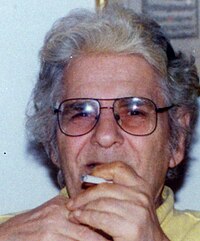Ahmad Shamlou | |
|---|---|
 | |
| Born | December 12, 1925 Tehran, Iran |
| Died | July 23, 2000 (aged 74) Karaj, Iran |
| Occupation | Poet, Encyclopedia and Journalism |
| Nationality | Iranian |
| Period | 1947–2000 |
| Literary movement | Modern literature |
| Notable works | In This Blind Alley The Book of Alley |
| Notable awards |
|
| Signature | |
 | |
| Website | |
| shamlou | |
Ahmad Shamlou (Persian: احمد شاملو, Ahmad Šāmlū Persian pronunciation: [æhˈmæd(-e) ʃɒːmˈluː], also known under his pen name A. Bamdad (Persian: ا. بامداد)) (December 12, 1925 – July 23, 2000) was an Iranian poet, writer, and journalist. Shamlou was arguably the most influential poet of modern Iran.[2] His initial poetry was influenced by and in the tradition of Nima Youshij. In fact, Abdolali Dastgheib, Iranian literary critic, argues that Shamlou is one of the pioneers of modern Persian poetry and has had the greatest influence, after Nima, on Iranian poets of his era.[3] Shamlou's poetry is complex, yet his imagery, which contributes significantly to the intensity of his poems, is accessible. As the base, he uses the traditional imagery familiar to his Iranian audience through the works of Persian masters like Hafez and Omar Khayyám. For infrastructure and impact, he uses a kind of everyday imagery in which personified oxymoronic elements are spiked with an unreal combination of the abstract and the concrete thus far unprecedented in Persian poetry, which distressed some of the admirers of more traditional poetry.
Shamlou has translated extensively from French to Persian and his own works are also translated into a number of languages. He has also written a number of plays, edited the works of major classical Persian poets, especially Hafez. His thirteen-volume Ketab-e Koucheh (The Book of Alley) is a major contribution in understanding the Iranian folklore beliefs and language. He also wrote fiction and screenplays, contributing to children's literature, and journalism.
- ^ "1999 ĺrs Stig Dagermanpristagare Ahmad Shamlou". Dagerman.se. Archived from the original on August 11, 2010. Retrieved August 9, 2010.
- ^ Fatemeh Keshavarz (2006). "Recite in the name of the red rose". USA: The University of South California Press. p. 2.
- ^ Dastgheib, Abdolali (2006) The Poet of Love and Dawn, Critical Review of poems by Ahmad Shamlou. Amitis Publishers, Tehran, Iran. ISBN 964-8787-10-7. (Persian title: شاعرعشق و سپیده دمان ).